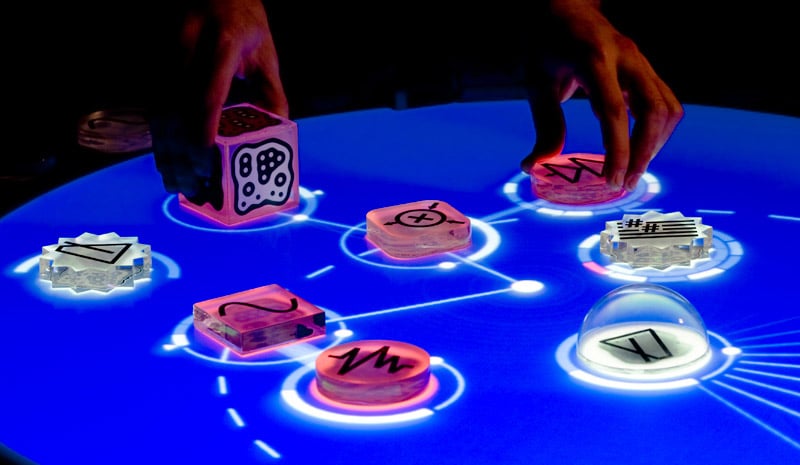
The reacTable, a new instrument that lets musicians manipulate sounds by moving glowing blocks on a round, transparent table, is wowing festival audiences after it was hand-picked by Björk for use on the singer’s summer tour.
The modular synthesizer mashes up shades of Tron, laser hockey and classic Moogs using open-source reacTivision software and an under-the-hood camera to track blocks that, when added, rotated or moved, combine to produce beeps, whoops and soaring synth lines.
The reacTable‘s developers say it is the latest in an emerging wave of “tangible music interfaces,” but to the touring musicians who play the thing, it’s merely “cool.”
“When I first got it, I thought, ‘Why don’t I just make a funny noise on the Moog?'” said Damian Taylor, a Grammy-nominated producer who engineered Björk’s latest album, Volta, and who plays the reacTable onstage with the Icelander.
“But, as soon as you start to use it, there’s really no comparison – it’s a completely different animal. They designed it so you draw your finger across the board, but I just wound up picking stuff up and banging it on the table and playing it more like rock ‘n’ roll power chords. We had to replace the bottoms of each of the blocks because I was wearing away the patterns.”
Each block has a different function – like changing a sound wave’s amplitude or acting as a metronome – that is denoted by a unique hieroglyph. Players move, rotate and flip the blocks, run their fingertips over the tabletop’s surface and alter the blocks’ proximity to each other to control the music produced by the machine. Pulsing visuals that light up the tabletop come courtesy of a projector beneath the reacTable’s translucent Perspex surface, making the instrument interesting to the eyes as well as the ears.
Developed as a Ph.D. project by music technology researchers at Barcelona’s Pompeu Fabra University, the instrument – which looks like a cross between Electroplankton and a Pac-Man cocktail table – started scientific tongues wagging at academic conferences and art-tech events two years ago. But now mainstream music fans’ jaws are dropping after Björk’s interest in the reacTable was piqued by a YouTube clip last fall.
Developers had envisaged the reacTable played gently and collaboratively by up to four players standing around the instrument.
But, in a paper presented in February to the Tangible and Embedded Interaction conference in Louisiana, they proposed a revolution in how artists make music. If Apple and Microsoft can shake up telephony and computing with their touchy-feely iPhone and surface computer, why can’t a new instrument transform pop music?
The reacTable gets a workout during Björk’s June performance of “Pluto” at the Glastonbury Festival in England.
Established instruments like the Moog, the turntable and the laptop are really powerful, but they do not provide the necessary control over the complex sound generation in the background,” said Martin Kaltenbrunner, one of the four-man team that created the reacTable.
“This is where tangible interfaces or multi-touch surfaces promise some new possibilities. We are interested in creating new electronic musical instruments which are more powerful for the musicians and allow the manipulation of the many possible parameters of synthetic sounds at any point.”
Kaltenbrunner’s device, at heart, is merely a classic synthesizer. But the reacTable can also reconnect electronic artists to a real musicianship that, for years, was hidden behind laptop screens and WYSIWYG software.
“I really like the fact you can get quite physical with it,” said Taylor, who has been learning the reacTable on the road. “You’re not just going through the motions every night. If you’re doing live electronic stuff, at least you’ve got something to grab on to.
“Each time you put an object on there you really don’t quite know what’s going to happen, so you just have to surf it, ride it and balance it out.”
ReacTable is not yet available to mere mortal musicians – but when Björk comes knocking, you don’t say no.
The singer particularly liked the visual feedback that lets the audience see how the reacTable makes music, Taylor said.
“She’s really into it,” he said. “She’s always been into people who come up with something totally fresh, and she really enjoys bringing out things that people haven’t seen before and giving a platform to really new ideas.”

